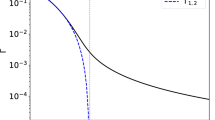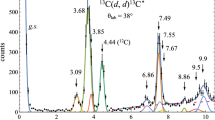Abstract
We revisit the fragmentation process \(g \rightarrow {\chi _{cJ}}+g\). Contrary to what was presented previously in the literature, our fragmentation functions are strictly positive, smooth, and vanish at \(z \rightarrow 1\).








Similar content being viewed by others
Notes
The presence of two Feynman diagrams where the gluon can be emitted either by a quark or by an antiquark does not produce the effect we are now discussing. The diagrams \(\mathcal{M}_1\) and \(\mathcal{M}_2\) are identical, and the interference is positive.
The authors compensate these negative contributions by introducing the color-octet mechanism. It may be an interesting question to motivate the presence of color-octet contribution in the photon fragmentation case \(\gamma ^*\rightarrow \chi _c\gamma \).
References
E. Braaten, T.C. Yuan, Phys. Rev. D 50, 3176 (1994)
E. Braaten, Y.-Q. Chen, Phys. Rev. D 55, 2693 (1996)
P.A. Zyla et al, Particle Data Group, Prog. Theor. Exp. Phys. 2020, 083C01 (2020)
E.J. Eichten, C. Quigg, Phys. Rev. D 49, 5845 (1994)
S. Fleming, A.K. Leibovich, Phys. Rev. Lett. 90, 032001 (2003)
S. Fleming, A.K. Leibovich, T. Mehen, Phys. Rev. D 68, 094011 (2003)
S. Fleming, A.K. Leibovich, T. Mehen, Phys. Rev. D 74, 114004 (2006)
M. Beneke, I.Z. Rothstein, M.B. Wise, Phys. Lett. B 40, 8373 (1997)
M. Beneke, in Proceedings of Second Workshop on Continuous Advances in QCD, Minneapolis, M. Polikarpov (ed.), World Scientific, Singapore, 1996; [hep-ph/9605462]
S.P. Baranov, Phys. Rev. D 91, 034011 (2015)
H. Krasemann, Z. Phys. C 11, 89 (1979)
G. Guberina, J. Kühn, R. Peccei, R. Rückl, Nucl. Phys. B 17, 4317 (1980)
Acknowledgements
The author thanks Andrei Prokhorov who pointed the author’s attention to the problem. This work was supported by the DESY Directorate in the framework of Moscow-DESY project on Monte Carlo implementations for HERA-LHC.
Author information
Authors and Affiliations
Corresponding author
Appendix: Off-shell production amplitudes for \(^3P_J^{[1]}\) states
Appendix: Off-shell production amplitudes for \(^3P_J^{[1]}\) states
Here we consider the gluon splitting subprocess
where the symbols in the parentheses indicate the momentum, the polarization, and the color of the interacting quanta. The produced quarks form a bound state \(p_{\chi }=p_c+p_{{\bar{c}}}\) with spin momentum \(S=1\) and angular orbital momentum \(L=1\).
The calculation of this subprocess at \({{\mathcal {O}}}(\alpha _s^2)\) refers to two Feynman diagrams:

with the property \({\mathcal{M}}_1={\mathcal{M}}_2\). The color factor is universal and is equal to \(\delta ^{ab}/2\sqrt{3}\). The amplitudes \({\mathcal{M}}_i\) contain spin projection operator which selects the spin-triplet \(c{\bar{c}}\) state:

where \(m_c\) is the c-quark mass and \(\epsilon _{S}\) is the \(c{\bar{c}}\) spin polarization vector.
The orbital angular momentum L is associated with the relative momentum q of the quarks in a bound state. The relative momentum q is defined as
According to a general formalism developed in [11, 12], the terms showing no dependence on q are identified with the contributions to the \(L=0\) state; the terms linear in \(q^\alpha \) are related to the \(L=1\) state with the proper polarization vector \(\epsilon ^\alpha \) (see below); the quadratic terms \(q^\alpha q^\beta \) refer to the \(L=2\) state with the polarization tensor \(\epsilon ^{\alpha \beta }\); and so on. The decomposition of \({\mathcal{M}}\) in powers of q is carried out by expanding the subprocess amplitude as
where q is assumed to be a small quantity.
The amplitude \({\mathcal{M}}(q)\) has to be multiplied by the bound state wave function \(\Psi (q)\) and integrated over q. A term-by-term integration of Eq. (18) is performed using the relations
etc., where \({\mathcal{R}}(x)\) is the radial wave function in the coordinate representation (the Fourier transform of \(\Psi (q)\)). Taking the trace in (15) and selecting the terms linear in q, with further replacing q with \(\epsilon _L\), yield:
The polarization vectors \(\epsilon _S\) and \(\epsilon _L\) are defined as explicit four vectors. In the frame where the z axis is oriented along the quarkonium momentum vector, \(p_{\chi }=(0,\,0,\,|p_{\chi }|,\,E_{\chi })\), these polarization vectors read
States with definite \(S_z\) and \(L_z\) can be translated into physical states \(\chi _J\) with definite total angular momentum J and its projection \(J_z\) using Clebsch–Gordan coefficients:
This completes our derivation of the production matrix element. The resulting expression has been explicitly tested for gauge invariance by substituting the gluon momenta \(k_i\) for their polarization vectors \(\epsilon _i\).
Rights and permissions
About this article
Cite this article
Baranov, S.P. Positively defined color-singlet fragmentation function \(g \rightarrow {\chi _{cJ}}\). Eur. Phys. J. Plus 136, 836 (2021). https://doi.org/10.1140/epjp/s13360-021-01836-8
Received:
Accepted:
Published:
DOI: https://doi.org/10.1140/epjp/s13360-021-01836-8




